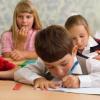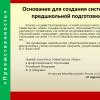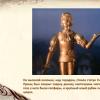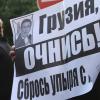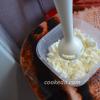Consultation on the main directions in the development of speech in children of senior preschool age. Consultation for parents “main directions in the development of speech in children of senior preschool age.” Direction Artistic and aesthetic development
Consultation for parents “Speech development in preschool age.”
What is meant by the concept of “Speech development in preschool age”? Speech is a form of human communication. At the beginning, the child’s speech improves in the process of communication with adults and peers; later, speech becomes the basis for the restructuring of thought processes and turns into a tool of thinking.
The main goals of speech development are mastering the norms and rules of the Russian language and developing children's communicative abilities.
Work on speech development in preschool age can be divided into 5 main areas:
- formation of sound culture of speech
- vocabulary enrichment
- formation of grammatical structure of speech
- teaching storytelling, coherent speech,
- development of expressive speech
Let's look at these areas in more detail:
Vocabulary enrichment:
It is clear to everyone that the richer a person’s vocabulary, the more complete his oral speech. But this also affects further schooling, where the child’s vocabulary will play a big role in mastering literate writing, when the child will need to select test words.
Let's try to play the game “Choose the epithets”:
I name the word, and you select epithets for it, let’s see who has the most (for the words snow, rain, man)
You can come up with a great variety of games, you can play them anywhere, for example, when you go to the garden, or while driving somewhere in the car. Well, here are a few of these games:
- “Who knows more words” - the adult asks the child a question: “I know the round wheel, and you?” and then “round words” are pronounced in turn: ball, apple, sun, etc.
- “Choose a word” - take turns calling “only dishes” or “only vegetables”
2. The areas of developing coherent, expressive speech and teaching storytelling are closely related. These skills help the child better convey his thoughts, emotions, experiences, and explain his own position.
Literary texts are a good help in this matter. Therefore, it is necessary for a child to read fairy tales, poems, and stories to children.
Texts for reading should be selected in accordance with age characteristics, special attention should be paid to the expressiveness of reading, for better perception of the text, you should pay attention to bright, high-quality illustrations. After reading a work, you should definitely take time to discuss what you read. Familiar fairy tales can be performed using a puppet show.
3. Work on the formation of the grammatical structure of speech involves several directions:
- work on sentence structure - the ability to come up with a sentence, use common sentences in speech.
- development of word formation and word change skills - here you can use games aimed at the formation of new forms of words - for example, the game “Change the Word” - an adult names the word in singular units. – the child must name in the plural.
- development of coherent speech - the ability to coordinate words in a sentence.
4. Parents are most concerned about sound pronunciation in children, because this is the most noticeable defect.
Accurate production of sound is only possible if the child’s pronunciation organs (in particular, the articulatory apparatus) are able to take the appropriate position and have sufficient mobility of the muscles involved in the formation of sound. Therefore, children first master the simplest sounds in pronunciation, and then more complex ones. The formation of sound pronunciation occurs by 5 years. If at the time of performance, any sound is not pronounced correctly, then we can talk about violations of the development of sound pronunciation in the child.
It will be easier for a child to master the pronunciation of individual sounds if you help him:
Articulatory gymnastics - helps improve blood supply to the articulatory organs, strengthen the muscular system of the tongue, lips, cheeks
Breathing games and exercises - blowing on balloons, paper strips, blowing up balloons, soap bubbles.
Finger games and exercises
Games aimed at developing sound pronunciation (individual sounds) - pronunciation of individual sounds, pure phrases.
I think you noticed. That all directions in the field of speech development are intertwined with each other, and by playing a game to enrich vocabulary development, the child learns at the same time to change words, form new ones, or by discussing a read work, the child learns to formulate a sentence grammatically correctly, so speech development does not occur , only in certain classes, but is also carried out throughout the entire time, both in games and in everyday life.
Today, as part of the topic of our parent meeting, I would like to raise one more issue in this direction. Quite often, you can hear from parents that a child already recognizes letters at 3-4 years old, and many strive to teach their child to read as early as possible. So here is the question that I would like to raise today: is it necessary to teach a child to read at a younger preschool age? I’ll answer this question right away – NO! And now I will try to explain my so categorical answer.
Reading is only part of learning to read. It is not at all difficult for a child to remember letters. But literacy is not just reading. You probably noticed that in our schedule there is a lesson “preparing for literacy”.
The main goal of our classes, and even the first - preparatory stage of learning to read - is to teach the child to listen to the word and hear it. In class we “play” with words, play with sounds. Children learn to hear sounds in words, distinguish them, learn to distinguish consonants from vowels, soft from hard, voiced from deaf. Why is this necessary: tell me what sound the word “Yolka” begins with, and the majority will immediately say that it starts with “E”, but there is no such sound, there is a letter! And this letter stands for two sounds “Y” and “O”. And here there is a peculiarity of a preschool child - as soon as he recognizes letters, he stops listening to sounds, for example, for him the words “bow” and “hatch” begin with the same letter, and therefore with the same sound. This means that in subsequent schooling, the child will also find it difficult to differentiate between hard and soft consonants.
That is why the first step in teaching literacy (and reading) is to develop the ability to hear sound; here games come to the rescue in which the child needs to determine the sound in a word, for example, “who can name the most words with the sound l.”
Next, after getting acquainted with the sounds, one gets acquainted with the sound analysis of the word, when, instead of letters, their symbols are used. Sound analysis of a word is the basis of competent writing.
And after the child has mastered the sound analysis of the word, letters are gradually introduced, and it is at this moment that the child can be explained that the same letter m can mean two sounds “m” and “m*” in the words “Masha” " and "Misha". And then the child will not have to work hard when adding syllables to form them, because children will already be able to analyze the letters and the syllables themselves will form! And then reading will not be a painful task, but an easy and pleasant time. But we will get to this only in the preparatory group. So be patient, and we will definitely come to learn to read, easily and freely.
Attached files
Municipal budgetary preschool educational institution, kindergarten No. 24, st. Kavkazskaya municipal formation, Kavkazsky district.
Consultation for parents
“The main directions in the development of speech in children of senior preschool age.”
Teacher Politskovaya T.V.
Date: February 2016.
Art. Caucasian
2016 – 2017 academic year
The main direction of speech development for children in the fifth year of life is the development of coherent monologue speech. Children of middle preschool age begin to actively master the methods of word formation. The child’s vocabulary is enriched with words denoting the qualities of objects and their actions. Children learn to select words with opposite meanings and compare objects and phenomena. At this age, an “explosion” of word creation begins. Children begin to use words in various grammatical categories and express their thoughts not only in simple but also in complex sentences. The ability to construct descriptive and narrative statements is mastered. In the speech of children of the fifth year of life, an understanding of the semantic side of speech, syntactic structure, and the sound side of speech are formed, i.e. skills and abilities necessary for further speech development. Children of the fifth year of life show a great attraction to rhyme. The child willingly selects and rhymes words. This activity helps develop speech hearing. However, the speech of children of this age is characterized by mobility and instability. A child can focus on the semantic side of words, but explaining the meaning causes difficulties. The speech of children of the sixth year of life is characterized by an increase in the level of speech development. A significant vocabulary is accumulated, the qualitative side of speech expands, i.e. concepts that are similar or opposite in meaning, as well as multi-valued. At this age, the most important stage of speech development is formed - the stage of mastering the grammatical system of the language and the ability to control one’s speech is developed. At this age, the need for dialogue is formed and dialogic speech develops. The ability to select the desired content and form of its expression develops. The most striking characteristic of the speech of older children is the active assimilation of different types of texts - description, narration, reasoning. Children learn to use intonation means of expressiveness, use grammatical categories of word formation and inflection. In this regard, difficulties arise in the correct formation of grammatical categories. Difficulties in constructing complex syntactic structures, which leads to incorrect combination of words in a sentence, disruption of the connection of sentences in a statement. The main goal of the work of preschool teachers is to teach children to use dialogic and monologue speech as a form of verbal communication. Dialogue speech is one of the components of coherent speech. In the process of educational activities on this form of work, children form ideas about the structure of a statement, the use of means of connecting words and sentences, ensuring its integrity, its logical sequence. Children also practice constructing sentences using typical forms of word formation and inflection. In dialogic speech, other important components are also improved - speech hearing, correct sound pronunciation, intonation expressiveness, and the skills of correct expressive speech are consolidated. Work outside the main educational activity is of great importance for the full speech development of children: on walks, in the morning and evening hours in a group and at home. Outside of educational activities, first of all, it is necessary to create conditions for the speech activity of each child during play, in routine moments, and in everyday life. To ensure the full development of vocabulary, it is necessary, along with everyday exercises, to make wider use of moments in everyday life that provide great opportunities for consolidating speech skills. To achieve these goals, speech therapist and speech group teachers need to maintain a close relationship with the parents of speech group children, cooperation and support.
1.4. The main directions of work on the development of speech in children of senior preschool age.
The main tasks of speech development are the education of sound
speech culture, vocabulary work, the formation of the grammatical structure of speech, its coherence when constructing a detailed
statements - are solved from group to group, however, at each age stage there is a gradual complication of each
tasks, and teaching methods change.
Speech tasks in relation to children of senior preschool age
age include the same sections as in the previous
ages, however, each task becomes more complicated, both in the sense of co-
holding, and in teaching methods.
A) Education of sound culture of speech,
The main task of the work is to assimilate and correctly
pronunciation of all sounds of the native language - further improvement of speech hearing, consolidation of clear,
correct, expressive speech.
B) Vocabulary work.
Work continues to enrich, clarify and activate the dictionary. Much attention is paid to developing children's ability to generalize, compare, and contrast. To the dictionary
children are introduced to words denoting the material from which
made object (wood, metal, glass), widely used
riddles and descriptions of objects, their properties, qualities, actions.
Particular attention is paid to working on the semantic side
words, expanding the stock of synonyms and antonyms, developing the ability to use words that most accurately match
to the situation
To enrich and clarify the vocabulary, the following techniques are used~;
A) the teacher names an object, action, quality, emphasizing a new word intonationally, and suggests repeating it;
b) children are invited to think about a new word
(It was a fine autumn day,” the teacher begins his
story and asks - What day do you think it was?);
c) preschoolers are offered a choice of several characteristics of objects and are asked, focusing on its external
view, choose the one that seems more accurate to them.
The vocabulary activation techniques most often used in working with children of senior preschool age include:
the following are worn;,
a) questions for children (What is it? Which one? What does it do? Where? When? How?
b) verbal didactic exercises; "Who's to say
more precisely?”, “Who will tell you more?”. “Who will say otherwise?”
(exercise on selecting synonyms), “Say the other way around” (using
use of antonyms) "
c) didactic game “Guess the riddle”, while re-
The teacher not only asks children riddles, but also encourages
them, focusing on the subject, picture, come up with your own. A variation of this game is the game “Tops-Roots.”
They determine the vegetable by the tops, or they select the tops for the vegetable.
woo"
" d) didactic games for grouping and qualification
items. They can be verbal using na-
visible material. Examples include the following:
blowing: “What is unnecessary? “Name it in one word” (pliers, hammer, plane, saw - these are tools), “Don’t forget anything,”
“Continue yourself”, etc. Remembering that the basis of grouping and class
siification is comparison; when working with children it is necessary
use games like “Similar and dissimilar” (orange and li-
mon, cow and horse). When developing the ability to compare, special attention is paid to identifying features of similarity and, above all, the main feature (these are fruits, these are animals, these are trees)
e) games - fables (What's wrong?),
c) formation of the grammatical structure of speech.
Older preschoolers continue to be taught those grammatical forms that they have difficulty mastering: agreement of adjectives and nouns
(especially neuter), formation of difficult verb forms in
imperative mood.
It is necessary to give the child complete orientation in the typical methods of inflection and word formation, to educate
linguistic flair, attentive attitude to the language, its grammatical structure, a critical attitude towards one’s own and others’ speech, the desire to speak correctly.
Particular attention is paid to the syntactic side of speech
the ability to build not only simple common ones, but also
complex sentences of different types.
Compiling a collective letter in a “written speech situation” (the child dictates, the adult writes down) helps improve the syntactic structure of the sentence.
The formation of the syntactic side of children's speech is necessary for the development of coherent speech.
d) Development of coherent speech.
In retelling literary works, children
learn to convey coherently, consistently and expressively
text without adult help.
Children practice telling stories from pictures, from a series of plot pictures, stories about toys, and compose stories from their own experiences. Storytelling classes are held weekly. Additionally (once or twice a month), didactic games and exercises for the formation of monologue speech are planned.
Since all types of work on the development of coherent speech
are equally important at this stage of training, the number of classes is distributed evenly between them. For every month
retellings of short fairy tales and stories, activities are planned
by description of toys and techniques; by describing plot pictures, by composing stories from experience.
Games that have a complex impact on vocabulary
grammar, coherence of speech, should be interesting and exciting.
Along with games that have a broad general educational
influence on speech, the method includes didactic games. IN
they raise questions of activation, clarification of this or that
grammatical form to help children master difficult
forms in inflection (genitive plural
numbers, imperative mood of the verb, word agreement in
gender, etc.), methods of forming words (names of baby animals, people of different professions, words with the same root).
Games and exercises are recognized as activating children's
search activity in the form of grammar, to cultivate in children a linguistic sense, a linguistic attitude to the word and elementary forms of awareness of linguistic reality.
For the sake of verbal techniques, vocabulary work has a special place
takes lexical exercises that help prevent speech defects and activate children's vocabulary.
They form practical skills in children: the ability to quickly choose the most accurate, appropriate word from their vocabulary, compose a sentence, distinguish shades in meanings.
reading words.
In older preschool age, in a playful way,
exercises are used to distribute sentences, coordinate the subject and predicate, and formulate a logical
stress, on composing a sentence according to a word, according to a diagram. For
This is used in the following games: “Living Words”, “We need to say it differently”, “What words have you heard” and so on.
To improve the structure of utterances, it is important
a role is played by teaching coherent speech and storytelling, which
may take a playful form.
A plot can give a playful form to learning; the inclusion of a task can be told in a role-playing game: a photo exhibition, a store, a postcard kiosk, a tour of one’s hometown.
The game uses the following techniques to answer questions (problematic questions: why, when, what if...), disseminate the child’s statements, enrich the child’s statements into a story,
retelling the beginning of the phrase.
Working both in specialized preschool institutions and in special groups of general education kindergartens. Let us consider the forms of organizing the correctional and pedagogical work of a defectologist with a family raising a young child with disorders of psychophysical development. In my opinion, the work of a speech pathologist with a family raising a child with disabilities...
Physico-chemical, but also to the social conditions of the external environment. Since for a defectologist, understanding the specifics of motivating sensations and images of varying degrees of complexity and the logic of their successive development forms the basis of correctional and educational work with abnormal children, the need for further targeted research in this direction, primarily psychological and pedagogical...
Not a single method developed by domestic scientists for studying the intelligence of children with disabilities. The above allows us to call G.I. Rossolimo is one of the founders of Russian defectology. A special area of his activity was research into the psyche of sick children and children with behavioral problems. He developed a program for observing children - “Plan for the Study of a Child’s Soul...
Meanwhile, perhaps, it is at this level of selection that the most significant shortcomings are revealed. In order to correctly assess the current state, the positive aspects and disadvantages of psychological diagnostics in the field of defectology, it is necessary to consider this diagnostics in three ways: theoretical, methodological and practical. Consideration from a theoretical perspective leads to the identification of theoretical...
Main directions V development speeches older children preschool age
Prepared by the teacher
preparatory group:
Antsupova E.V.,
November 30, 2017
The most important acquisition in preschool age is the mastery of speech as a means of understanding what surrounds him and those around him.
Preschool age is the most suitable period for the enrichment and development of speech, since if by the age of 6-7 years a child has not reached a certain level of speech development, then it will be difficult for him, and, first of all, when entering school and studying in the primary grades, after all, communication both with other children, classmates, and with teachers and other adults will also be very difficult. At an older age, speech acquisition, as practice shows, is less successful. And since communication is an indispensable condition for the development of children of senior preschool age in general, especially great attention must be paid to the formation of this mental process. The kindergarten provides various programs and technologies for teaching children, including those aimed at developing the speech and vocabulary of a preschooler, and features of teaching the native language. These are, perhaps, obvious features of speech development and learning in a preschool institution.
The speech of children of the sixth year of life is characterized by an increase in the level of speech development. A significant vocabulary is accumulated, the qualitative side of speech expands, i.e. concepts that are similar or opposite in meaning, as well as multi-valued. At this age, the most important stage of speech development is formed - the stage of mastering the grammatical system of the language and the ability to control one’s speech is developed. At this age, the need for dialogue is formed and dialogic speech develops. The ability to select the desired content and form of its expression develops. The most striking characteristic of the speech of older children is the active assimilation of different types of texts - description, narration, reasoning. Children learn to use intonation means of expressiveness, use grammatical categories of word formation and inflection. In this regard, difficulties arise in the correct formation of grammatical categories. Difficulties in constructing complex syntactic structures, which leads to incorrect combination of words in a sentence, disruption of the connection of sentences in a statement.
Level detection speech development Children are also important in determining school maturity, because full mastery of their native language is the most important prerequisite for success in establishing relationships with teachers, peers, and in mastering the entire volume of new information that is presented to children in verbal form.
In teaching children There are three areas of speech development : structural (formation of sound, grammatical aspects speeches) ; functional (formation of dialogic monologue speeches, verbal communication ); cognitive or cognitive (development elementary knowledge of language phenomena, speeches).
Research has shown that the greatest effectiveness is when mastering any structural components speeches is achieved provided that children are involved in active work on drawing up different options speech units, their change and education.
In studies of the second directions it is possible to find clearer criteria for coherence speeches, than just its logic and consistency. As main The indicator of coherence is taken to be children’s ability to structurally correctly construct a text, using the necessary means of communication between sentences and parts of a statement.
If in studies of the first and second directions communication and awareness of linguistic phenomena enter only as one of the conditions for the successful acquisition of elements of vocabulary and grammar, then the study of the third directions are directly aimed at developing children’s initial linguistic concepts, understanding what a word or sentence is, how they are constructed, what parts they consist of.
IN basis of speech development lies the active creative process of language acquisition, formation speech activity . It is well known that children, even without special training, from a very early age show great interest in language activities, create new words, focusing on both the semantic and grammatical aspects of the language. However, in case of spontaneous speech development only a few of them reach a high level. Therefore it is necessary targeted speech and speech training development. The central task of such training is the formation of linguistic generalizations and elementary knowledge of the phenomenon of language and speeches. Grammatical structure is the logic of a language, its organizing principle, ensuring the use of all its means in a coherent manner. speeches. Children's Researchers speeches distinguish two interrelated processes in the development grammar: imitation and linguistic generalization. The important role of linguistic generalizations in mastering grammar is evidenced by innovations in the field of inflection and word formation. Linguistic innovations are evidence that the child has learned the meaning of grammatical elements and the rules for operating them and applies these rules in a new problem situation.
One of the important indicators general speech development child - his initiative speech. It occurs most often in conditions of communication with adults and peers as a means of expressing his needs. Initiative speech, therefore, can serve not only as an indicator child's speech development , but also an indirect characteristic of the sphere of his needs.
The main goal of the work of preschool teachers is to teach children to use dialogic and monologue speech as a form of verbal communication. Dialogue speech is one of the components of coherent speech. In the process of educational activities on this form of work, children form ideas about the structure of a statement, the use of means of connecting words and sentences, ensuring its integrity, its logical sequence. Children also practice constructing sentences using typical forms of word formation and inflection. In dialogic speech, other important components are also improved - speech hearing, correct sound pronunciation, intonation expressiveness, and the skills of correct expressive speech are consolidated.
Preschool age is a period of active acquisition by a child of spoken language, the formation and development of all aspects of speech - phonetic, lexical, grammatical. Full command of the native language in preschool childhood is a necessary condition for solving the problems of mental, aesthetic and moral education of children in the most sensitive period of development. The sooner learning the native language begins, the more freely the child will use it in the future; this is the foundation for the subsequent systematic study of the native language.
The system of speech work should be based on an integrated approach aimed at solving problems covering different aspects of speech development - phonetic, lexical, grammatical, and on their basis - the development of coherent speech.
It is well known that children, even without special training, from a very early age show great interest in linguistic reality, create new words, focusing on both the semantic and grammatical aspects of the language. With spontaneous speech development, only a few of them reach a high level, so targeted training in speech and verbal communication is necessary. The central task of such training is the formation of linguistic generalizations and elementary awareness of the phenomena of language and speech. It creates interest in children in their native language and ensures the creative nature of speech. Elementary school teachers note that by the time they enter school, not all children have mastered the ability to correctly and competently construct a statement, talk about something, describe a phenomenon, reason; not all children are familiar with the rules for constructing a text, its structural parts and elementary connections between them.
Thus, when teaching your native language, it is necessary to rely on knowledge of the formation and development of the phonetic, lexical, and grammatical aspects of the language at different age periods.
Thus, in dictionary work, special attention should be paid to the semantic aspect, using the following methods and techniques: selection of synonyms and antonyms for isolated words and phrases; replacing a word in a phrase, selecting the most accurate word in meaning; composing sentences with synonymous words; composing phrases and sentences of various types with words of different parts of speech; finding polysemantic words in proverbs, sayings, riddles, tongue twisters and in literary works - fairy tales, poems, stories; drawing on the theme of a polysemantic word and then talking about what was drawn; compiling stories on a self-selected topic.
Assignments for vocabulary work closely intertwined with the tasks of formation of grammatical structure speech. Questions: what kind of hare (fluffy, soft, careful), what kind of fur coat does he have (warm, smooth), what kind of bunnies (fast, nimble), what mood (cheerful, playful) - require agreement in gender and number of nouns and adjectives.
Or a task for selecting verbs of motion - children first name the infinitive (run, jump, walk, ride), then phrases (go home, ride a bike, play football), then make sentences (I am parachuting; I am flying with an arrow), and then two sentences (I am learning to run fast. Every day I play football). Such exercises are given to select words denoting actions, or words necessary for communication between people associated with the act of speaking (talk, tell, ask, answer, talk, whisper, think, reflect, reason, talk).
It is necessary to talk with children about what a description, a plot story, is. The accuracy of word usage is developed in such exercises when children form words with semantic shades of increase, diminutive, endearment (hand-hand, leg-leg, old-old, plump-plump).
Children can be taught to distinguish the semantic shades of verbs depending on the prefix in such exercises. To name the verb to play, children must find different forms of this verb and make sentences (I play the harmonica; I got lost in playing and didn’t notice how time flew by; Misha beat a friend at chess, etc.). After this, invite the children to come up with a story, i.e. develop the topic. Thus, there will be direct access to coherent speech.
Each lesson and all exercises should be aimed at using a word, phrase, sentence in a coherent statement, and the idea of structure should be reinforced in the story through a series of plot pictures.
Identification of the level of speech development needs to be carried out on all sides: phonetic, lexical, grammatical in conjunction with the development of monologue speech.
Group I of tasks reveals the child’s understanding of the meaning of words (including polysemantic ones), the ability to combine words according to their meaning and accurately use them in a statement.
Group II of tasks is aimed at identifying the ability to select words with the same root, coordinate nouns and adjectives in gender, number and case, form difficult forms of the imperative and subjunctive mood (jump, dance, hide; would run away), mastery of different methods of word formation.
Group III of tasks will reveal the ability to build a storyline in a series of pictures, connecting parts of a statement in different ways of connections, smoothly presenting the content, finding a variety of intonation characteristics when composing a narrative story.
First task: “What does the word...doll (ball, dishes) mean?” almost all children do. The definitions given by them indicate an understanding of the meaning (meaning) of the proposed words: “A ball is an inflatable rubber ball, a dish is a glass object from which one eats” (Sasha K.); “A doll means a toy, they play with it” (these were the majority of answers).
When a polysemantic word (pen, needle) is given as the initial word, it is clear from the children’s responses which meaning of the presented words the child is guided by. Explaining the meaning of the word “pen,” children first of all highlight the pen as a writing instrument: “A pen is an object that is used for writing” (Sasha K.); “This means what we write with” (Katya M,). However, there were other definitions of this ambiguous word: “When we open the door, we take hold of the handle”; “This is a car handle, the little one has a hand” (Volodya Z.). “A baby may have a pen, and there may be a pen with which you can write” (Olya Ts.). “The needle is sharp. There are needles on hedgehogs and birds” (Gena P.). “A sewing needle, the Christmas tree has a needle, the hedgehog has a needle” (Lisa Y.).
The above examples indicate that the subject of children’s reasoning in this case is the word itself. At the same time, the structure of the answer itself is of great interest: its accuracy, brevity, and the ability to highlight the essential.
The answers when performing grammar tasks become very revealing. Children mostly name their babies correctly. The only difficulty that arose was the name of the baby sheep (sheep), giraffe (giraffe cub), and horse (little horse). Not all children will be able to complete tasks on word formation of words with the same root. It is given like this: “What words can be formed from the word “snow” so that this part “snow” or “snow” can be heard in the word. Only after leading questions do children name the words: snowball, snowball, snowman. Formation of new words causes even more difficulties from the word “forest” (lesok, forest, little forest). Some children called the word “fox” (Liza Ya.).
Most children compose sentences with imperative verbs. The children are given the task: “Tell the bunny to jump (dance, hide).” The task is set in such a way that the child himself “finds” the required form. And there will be many different answers here. Some children say: “Hide, dance, dance.” Or: “He jumped, the bunny hid, he will dance” (Gena P.).
Not all children correctly complete the task of forming the subjunctive mood: “What would a bunny do if he met a wolf in the forest?” Answer: he would be scared, he would run away, he would hide - many gave without the particle “would” (i.e. they said: he ran away, he was scared). Then offer the child 4 pictures united by a plot. You need to arrange them in a certain sequence and compose a story. Laying out the pictures (a girl goes with a basket to pick mushrooms - after parting the grass, she sees a family of hedgehogs - the hedgehogs help the girl collect a full basket of mushrooms - she says goodbye to them) will show whether the child has an idea of the plot and how developed his logical thinking is. The majority of children (70%) cope with this task, but the process of storytelling itself revealed some peculiarities.
Children's stories are assessed according to the following indicators.
- Content, i.e. the ability to come up with an interesting story.
- Story composition: the presence of three structural parts (beginning, middle, end) was present in most stories, since the very construction of the plot according to a series of pictures “helped” the children to come up with a story as if according to a scheme. At the same time, many did not know how to start a story (what beginning to choose) and how to finish it.
- Grammatical correctness. Many stories contain direct speech. However, there are errors in the construction of sentences, simple and complex, and in the correct agreement of words in phrases and sentences.
- Various ways of connections between sentences and parts of statements. This indicator had the most deviations. Most often, children use formal compositional methods to connect sentences: conjunctions “and”, “a”, adverbs “then”, “and then”. When these connectives are used in almost every sentence, the text loses its main characteristic - coherence.
- Variety of lexical means (use of different parts of speech, figurative words - definitions, comparisons). For many children, this indicator received a good rating (the children called the day clear, warm, sunny; they used different verbs denoting actions: walked - looked - hung - pulled apart - asked - allowed - helped - picked up - carried out - said goodbye).
- The sound design of statements was highly appreciated by most children: diction, lack of monotone, intonation expressiveness of speech.
So, we present to your attention examination technique. The proposed tasks allow us to identify the child’s success in mastering program tasks for speech development and the degree of proficiency in the lexical, grammatical, phonetic side of speech and its coherence when constructing different types of statements. The ability to complete the task for each speech task is revealed.
Vocabulary work- understanding the semantic side of a word: determining the meaning of a word, selecting synonyms, antonyms and associations for polysemantic words of different parts of speech, identifying the accuracy of word usage in reasoning and narrative statements.
Grammar - understanding the concepts of “word”, “phrase”, “sentence”; agreement of nouns and adjectives in the genitive plural; formation of new words with a given base; determining the semantic structure of a sentence; drawing up proposals of different types.
Phonetics - understanding of the terms “sound”, “syllable”, sound analysis of a word, sound design of a statement: speech rate, diction, voice control, intonation of sentence and statement completeness, smoothness of text presentation, its intonation pattern, expressiveness of speech.
Coherent speech - the construction of coherent statements of different types - reasoning, narration; the ability to structure a text, develop a plot through a series of pictures, connect parts of a statement using different methods of connections in a grammatically correct and precise manner.
In general, the entire block of tasks reveals preschoolers’ orientation in linguistic reality, the ability to differentiate the concepts of “sound”, “syllable”, “word”, “sentence”, “text”. In addition, the ability to understand instructions and carry them out in accordance with the task is also revealed.
Methodology for identifying the level of speech development of older preschoolers
- You know a lot of words. Say any words.
- Now you and I will play with words. I will tell you my word, and you will tell me yours.
- needle, bell, lightning;
- light, sharp, deep.
- walk, fall, run.
- Explain why you chose the word “….” for the word “needle”.
- Come up with a sentence with the words “big - huge, secret - mystery.”
- Choose words that have opposite meanings:
- long, light, fast;
- talk, laugh, ask;
- loud, a lot, easy.
- What does the word... "ball" mean? "pen"?
- Name what sounds the word “ball” is made of? "pen"? What's the first sound? Second? Third? ...How many syllables are in the word "ball"? "pen"?
- Make up a sentence with the word "ball" and the word "handle".
- What's the first word? Second? Third?…
- I have one red ball, but you have a lot of things? (red balls). There is one white birch tree growing in the clearing, and there are many (white birch trees) in the grove. I have one green apple, and you have many...green apples.
- Snow, snowman - what common part is heard in these words? What other words are formed from the word "snow"? Forest, forester - what is the common part in these words? Name other words so that this common part “forest” can be heard.
- Finish the sentences when I stop. "The animals were walking in the forest. Suddenly the hedgehog screamed, because... He stopped so that... The animals began to think how... When evening came..."
- Arrange the pictures to make a story.
- Write a story based on a series of paintings. Come up with an interesting title for your story.
The survey reveals that, in general, children of older groups who are planning to enter school show a good level of performance in two groups of tasks. Individual children have different assessments of the development of coherent speech and mastery of the lexical and grammatical aspects of speech, but these differences are not significant.
Language learning and speech development should be considered not only from a purely linguistic point of view (as the child’s mastery of language skills - phonetic, lexical, grammatical), but also in the context of the development of children’s communication with each other and with adults (as the formation of communicative abilities). Therefore, an essential task of speech education is the formation of not only a culture of speech, but also a culture of communication.
The main tasks of pedagogical work on speech development are identified, each of which corresponds to a specific set of private educational tasks.
Among the first are:
- development of coherent speech;
- development of the lexical side of speech;
- formation of grammatical structure of speech;
- development of the sound side of speech;
- development of figurative speech.
Development of coherent speech. The solution to this problem involves the development of two forms of speech - dialogical and monological. When developing dialogical speech, special attention is paid to developing in children the ability to build a dialogue (ask, answer, explain, etc.), using a variety of linguistic means in accordance with the situation. For this purpose, conversations are used on a wide variety of topics relating to the child’s life in the family, in kindergarten, etc.
It is in dialogue that the ability to listen to the interlocutor, ask a question, and answer depending on the context is developed. All these skills are necessary for the development of monologue speech in children.
The central point in the development of such speech is teaching children the ability to construct a detailed statement. This presupposes the formation in them of elementary knowledge about the structure of the text (beginning, middle, end), ideas about the connection between sentences and structural links of the statement. The latter is an important condition for achieving coherence in a speech utterance.
When teaching preschoolers how to construct coherent texts, it is necessary to develop the ability to reveal the topic and main idea of a statement and to title it.
Intonation plays a major role in organizing a coherent utterance. Therefore, developing the ability to correctly use the intonation of a separate sentence contributes to the development of structural unity and semantic completeness of the text as a whole.
The subprogram provides for teaching children various types of statements - according to the method of transmitting information or the method of presentation: description, narration, reasoning.
Development of the lexical side of speech. Work on the word - the original unit of language - occupies one of the most important places in the overall system of work on speech development.
Mastering the vocabulary of the native language is a necessary condition for mastering its grammatical structure, developing coherent monologue speech, and cultivating the sound side of the word.
Working on a word is, first of all, working on understanding its meaning. The child must be introduced to different meanings of the same word in order to ensure its semantically adequate use and the formation of a generalized idea of the word. The child’s developed ability to use words and phrases in accordance with the context and speech situation creates the prerequisites for free and flexible use of linguistic means when constructing a statement.
Of course, children learn verbal designations (names of objects) in the course of familiarization with the surrounding reality - both spontaneous and specially organized. However, the vocabulary of preschoolers needs not only quantitative enrichment, but also qualitative improvement. This requires special pedagogical work to clarify the meaning of words, teach the semantically adequate use of synonyms, antonyms, ambiguous words, and develop the ability to understand figurative meanings.
In the development of preschoolers' vocabulary, the principle of combining words into thematic groups is extremely important. Units of language are related to each other. The set of words that make up the thematic series forms a semantic field, which is located around the core. For example, the polysemantic word “needle” in the meaning “leaf of a coniferous tree” is included in the semantic field: tree - trunk - branches - needles - green - fluffy, grows - falls; a sewing needle enters another semantic field: sew - sew up - embroider - dress - shirt - pattern - sharp - dull, etc.
In the process of vocabulary work (as in solving other problems of speech education), one should strive to ensure that the child’s speech acquires such qualities as accuracy, correctness, and expressiveness.
Ultimately, it is necessary to develop in children the ability to select for expression those lexical means that adequately reflect the speaker’s intention.
All of the above aspects of lexical work are presented in this subroutine. This work is carried out in the form of verbal exercises and creative tasks.
Formation of the grammatical structure of speech. In the process of mastering speech, the child acquires the ability to form and use grammatical forms.
Taking this into account, the subprogram provides special work on morphology (changing words by gender, number, case), word formation (formation of one word based on another using special means), syntax (construction of simple and complex sentences).
The morphological structure of preschool children's speech includes almost all grammatical forms (with the exception of some); it becomes more complex as children age. In children's speech, the proportion of nouns and verbs is greatest, but the child increasingly begins to use other parts of speech - adjectives, pronouns, adverbs, numerals, etc.
When working on nouns, children learn the correct use of case forms (especially genitive forms in the plural), and become familiar with various ways of agreeing a noun with adjectives and verbs. When working on verbs, children learn to use them in the form of the 1st, 2nd and 3rd person singular and plural, to use the gender category, correlating the action and the subject with the feminine gender (the girl said), the masculine gender (the boy read) or neuter (the sun was shining) with past tense verbs. Children are also led to the formation of the imperative mood of an action verb, to which someone encourages someone (go, run, run, let him run, let’s go) and to the formation of the subjunctive mood - a possible or intended action (would play, read ).
When working on adjectives, children are introduced to how a noun and an adjective agree in gender, number, case, with full and short adjectives (cheerful, cheerful, cheerful, cheerful), with degrees of comparison of adjectives (kind - kinder, quiet - quieter). Children also learn different ways of word formation. Thus, they develop the ability to form a word on the basis of another word of the same root with which it is motivated, using affixes (endings, prefixes, suffixes), etc.
Mastering different methods of word formation helps a preschooler to correctly use the names of baby animals (bare, fox), tableware (sugar bowl, candy bowl), direction of action (rode - went - left), etc.
When working on syntax, children are taught ways to combine words into phrases and sentences of different types - simple and complex. The formation of complex syntactic structures in children's statements is carried out in a “written speech situation,” when the child dictates and the adult writes down his text.
When teaching children how to construct sentences, special attention is paid to exercises on using the correct word order, overcoming syntactic monotony (repetition of similar constructions), correct word agreement, etc.
Along with this, children develop a basic understanding of the structure of sentences and the nature of the use of vocabulary in sentences of different types, and the ability to consciously use linguistic means (words, phrases, sentences) when conveying their thoughts.
Development of the sound side of speech. When mastering the sound means of language, the child relies on speech hearing (the general ability to perceive the phonological means of language).
Linear sound units (sound - syllable - word - phrase - text) have independent extension and follow each other. At the same time, the features of the sound side of speech are reflected by prosodic units: word stress, intonation (melody of speech, strength of voice, tempo and timbre of speech).
Practical knowledge of a language presupposes the ability to distinguish by ear and adequately reproduce all sound units of the native language. Therefore, work on the formation of sound pronunciation in preschoolers should be carried out systematically.
Important means of sound expressiveness of speech are tone, timbre, pauses, and different types of stress.
A special layer of educational work is associated with the development in children of the ability to use intonation - to build an intonation pattern of a statement, conveying not only its meaning, but also its emotional “charge”. In parallel with this, the ability to use tempo, volume of pronunciation depending on the situation, and clearly pronounce sounds, words, phrases, sentences (diction) is being developed. By drawing the child's attention to intonation, the teacher develops his ear for speech, a sense of timbre and rhythm, a sense of the power of sound, which subsequently influences the development of his ear for music.
In general, by working on the sound side of speech, the child masters the ability to “subordinate” the utterance to the goals and conditions of communication, taking into account the subject and topic of the utterance, and the characteristics of the listeners.
Development of figurative speech. A child’s speech becomes figurative, spontaneous and lively if he develops an interest in linguistic richness and develops the ability to use a wide variety of expressive means when constructing statements. (Let us pay attention to the paradox: spontaneity is also cultivated! Moreover, what is even more paradoxical, it is cultivated in the process of the child mastering special means. However, this is the uniqueness of human cultural development.)
The most important sources for the development of expressiveness of children's speech are works of fiction and oral folk art, including small folklore forms (proverbs, sayings, riddles, nursery rhymes, counting rhymes, phraseological units). The subroutine determines specific ways to develop a child’s figurative speech through literary works of different genres (fairy tales, short stories, poems) and small folklore forms.
The development of imagery is an essential aspect of speech development in its entirety.
Thus, the lexical side of speech serves as an integral part of imagery, because semantic analysis contributes to the development of the ability to use a word or combination that is precise in meaning and expressive in accordance with the context of the statement.
The grammatical aspect of imagery is no less significant, since using a variety of stylistic means (word order, construction of different types of sentences), the child formats his statement grammatically correct and at the same time expressive. The phonetic side is associated with the sound design of the text (intonation expressiveness, optimally chosen tempo, diction), which largely determines the nature of the emotional impact on listeners.
The development of all aspects of speech, taken in the aspect of its imagery, is a fundamental condition for the development of independent verbal creativity, which can manifest itself in a child in composing fairy tales, stories, poems, nursery rhymes, and riddles.





